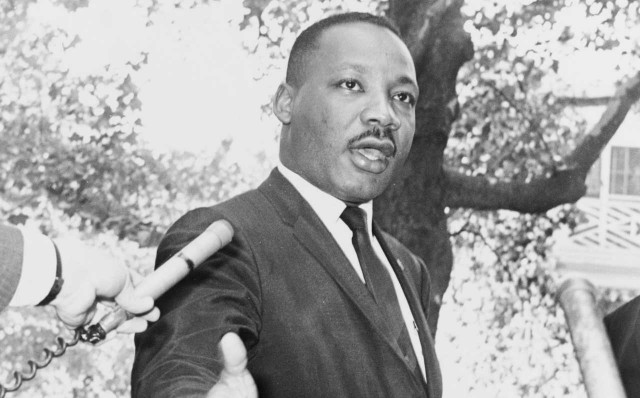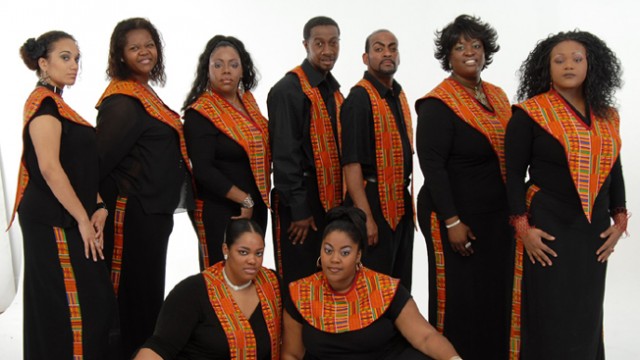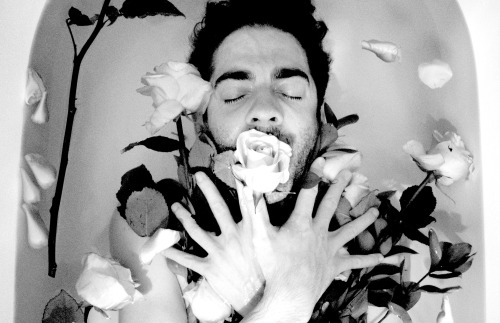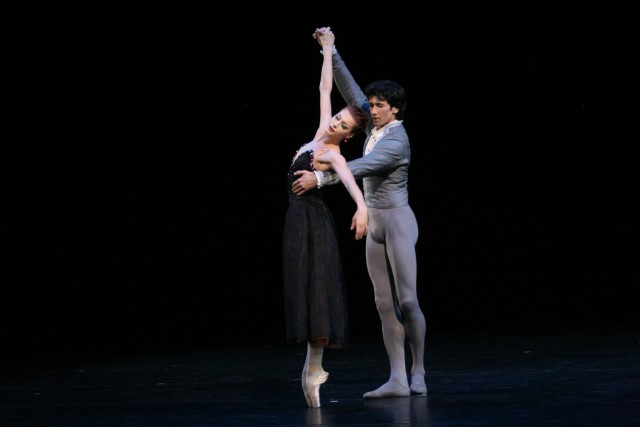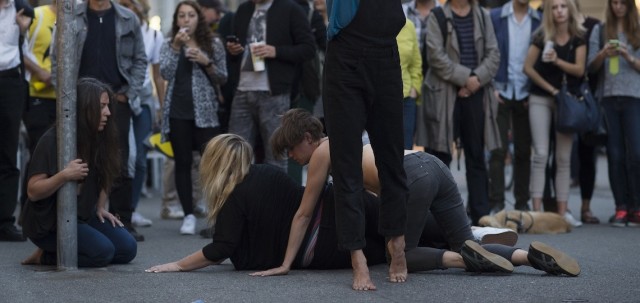
Luciana Achugar’s OTRO TEATRO moves indoors for AMERICAN REALNESS festival at Abrons Arts Center (photo by Alex Kangangi)
AMERICAN REALNESS
Abrons Arts Center Playhouse
466 Grand St. at Pitt St.
Thursday, January 15, 6:30, and Saturday, January 17, 4:30, $20
212-598-0400
www.lachugar.org
www.americanrealness.com
There’s a lot of pleasure to be had in Otro Teatro: The Pleasure Project, the culmination of luciana achugar’s three-month exploration of public intervention, individual and collective ritualized movement, and the relationship between performer and spectator. As its title suggests, it is “other theater,” an unusual, experimental approach to dance and performance, part of the American Realness festival at Abrons Arts Center. But first things first: It’s best to know as little as possible about this eighty-minute evening-length work. If you like nontraditional, challenging, immersive dance theater, then just buy your tickets and go. They don’t even hand out the programs until you’re on your way out; instead, you’re given a small piece of paper with a quote about the body, including: “a body in pleasure with eyes that see without naming, they see without knowing….” But if you truly need to know more and don’t want to experience the numerous surprises that achugar (The Sublime Is Us, A Supernatural Return to Love) has in store for you — and there are surprises galore every step of the way in this unconventional, invigorating theatrical premiere — then read on.
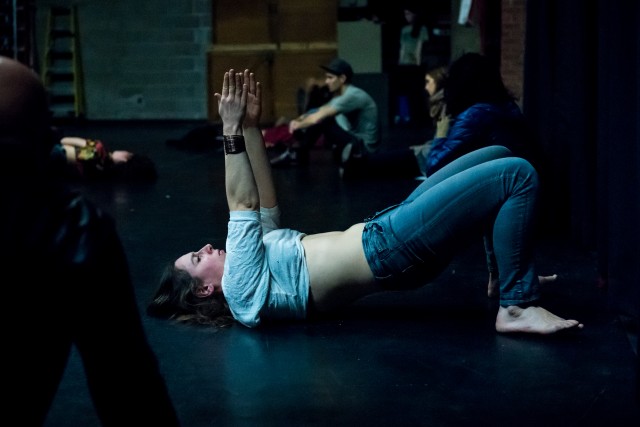
Luciana Achugar explores the relationship between performer and spectator, as well as the performance space itself, in OTRO TEATRO: THE PLEASURE PROJECT (photo by Ian Douglas)
Spoilers Galore: Otro Teatro takes place in the Abrons Arts Center Playhouse, but instead of sitting in the cushiony red seats in the audience, you’re led through a hallway onto the stage itself, where you can sit or stand anywhere on the four sides of what has now become a small black box space. The lights are on and the curtain is closed as several bottles of Old Taylor are passed around, with everyone invited to take repeated swigs of the “Kentucky Straight Bourbon Whiskey of Topmost Class.” Slowly, a few people break away from the mingling and start moving determinedly. One pounds her feet on the floor. Another kicks an aluminum gate. A third slithers like a snake. A fourth bangs against a post. At times it evokes a group of zombies waking up, getting their brain-hungry day started. As the performers, one of whom might be right next to you, continue to reveal themselves, it becomes confusing; someone stretching might just be someone stretching and not part of the show. Then again, you start wondering if anyone can participate, as it appears to be so random, and the performers come in all different shapes and sizes. Eventually, the lights go out, and in the darkness the sound and movement continue until the curtains are being pushed back and forth, opening up onto a whole new world. A few of the performers squiggle toward the rim of the stage and tumble over, reversing the usual stage-star dynamic as the audience, onstage, watches a handful of dancers making their way over chairs and up and down the aisles, pounding doors and creeping through the rows. The crowd follows the dancers toward the front of the stage, a few audience members even walking down the steps and finding a seat as action keeps going on all around them. Soon clothes start coming off as well. It’s part zombie apocalypse (evoking Bruce High Quality Foundation’s short film Isle of the Dead, about zombies heading toward a theater on Governors Island), part 1960s happening, with Old Taylor still making the rounds. The show never really ends; it just peters out, as ushers start asking the audience to grab their things and head for the exits, even as naked dancers are not quite done yet, scratching the walls and hiding beneath some seats. So, what was it all about? You won’t find the answer in the program, which is three pages of bios of the cast and crew and acknowledgments; they even left the fourth page blank, leaving it up to you to figure out what you’ve just experienced. Which, of course, is always the way it should be.
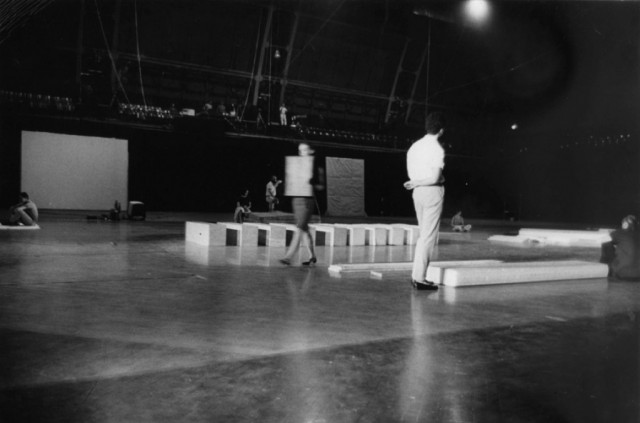
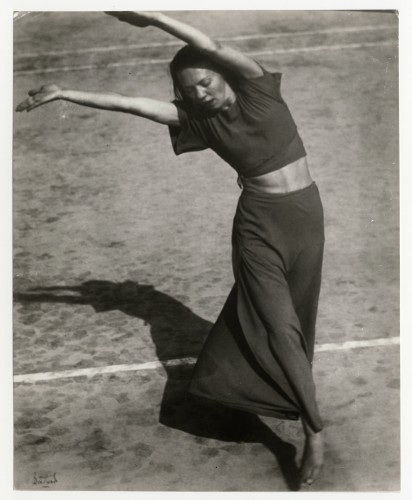
 Greg Vander Veer’s Miss Hill: Making Dance Matter is a charming celebration of a woman who had a tremendous impact on the development of modern dance but is still little known outside her tight-knit circle. Born in 1900 in a small town in Bible Belt Ohio, Martha Hill danced with Martha Graham before concentrating on teaching the art form, which as a child she was told was sinful, at Bennington and NYU. But she created her legacy as the first director of dance at Juilliard, where she taught from 1951 to 1985, balancing instruction in both modern dance and classical ballet. Vander Veer (Keep Dancing) and coordinating producer Vernon Scott, who graduated from Juilliard in 1985 and is currently president of the board of directors of the Martha Hill Dance Fund, combine wonderful archival footage of Hill as both a dancer and a teacher, along with old clips of many of her students, including Pina Bausch, Lar Lubovitch, Bessie Schönberg, Hanya Holm, José Limón, and Doris Humphrey, as well as fellow teacher Antony Tudor; there are also new interviews with Paul Taylor, Martha Clarke, Francis Patrelle, Robert Battle, Ohad Naharin, Dennis Nahat, H. T. Chen, and others. “She’s created the dancers of the twenty-first century,” says former Boston Ballet artistic director Bruce Marks. One of the most fascinating parts of the eighty-minute documentary is Hill’s fight to preserve Juilliard’s dance program during the building of Lincoln Center, which pitted her against George Balanchine’s School of American Ballet, the New York City Ballet, and Lincoln Kirstein. Miss Hill displays its subject with clarity, smartly exploring her understanding that dance is more than just language and movement. “Modern dance is not a system, it is a point of view,” Hill explains. Meanwhile, Patrelle gets right to the heart of the matter: “She was dance. She defined it.” A lovely treat for dance fans, Miss Hill opens January 23, at the Quad, with Vander Veer and Scott participating in Q&As following the 7:00 shows Friday and Saturday and the 4:30 shows Saturday and Sunday.
Greg Vander Veer’s Miss Hill: Making Dance Matter is a charming celebration of a woman who had a tremendous impact on the development of modern dance but is still little known outside her tight-knit circle. Born in 1900 in a small town in Bible Belt Ohio, Martha Hill danced with Martha Graham before concentrating on teaching the art form, which as a child she was told was sinful, at Bennington and NYU. But she created her legacy as the first director of dance at Juilliard, where she taught from 1951 to 1985, balancing instruction in both modern dance and classical ballet. Vander Veer (Keep Dancing) and coordinating producer Vernon Scott, who graduated from Juilliard in 1985 and is currently president of the board of directors of the Martha Hill Dance Fund, combine wonderful archival footage of Hill as both a dancer and a teacher, along with old clips of many of her students, including Pina Bausch, Lar Lubovitch, Bessie Schönberg, Hanya Holm, José Limón, and Doris Humphrey, as well as fellow teacher Antony Tudor; there are also new interviews with Paul Taylor, Martha Clarke, Francis Patrelle, Robert Battle, Ohad Naharin, Dennis Nahat, H. T. Chen, and others. “She’s created the dancers of the twenty-first century,” says former Boston Ballet artistic director Bruce Marks. One of the most fascinating parts of the eighty-minute documentary is Hill’s fight to preserve Juilliard’s dance program during the building of Lincoln Center, which pitted her against George Balanchine’s School of American Ballet, the New York City Ballet, and Lincoln Kirstein. Miss Hill displays its subject with clarity, smartly exploring her understanding that dance is more than just language and movement. “Modern dance is not a system, it is a point of view,” Hill explains. Meanwhile, Patrelle gets right to the heart of the matter: “She was dance. She defined it.” A lovely treat for dance fans, Miss Hill opens January 23, at the Quad, with Vander Veer and Scott participating in Q&As following the 7:00 shows Friday and Saturday and the 4:30 shows Saturday and Sunday.